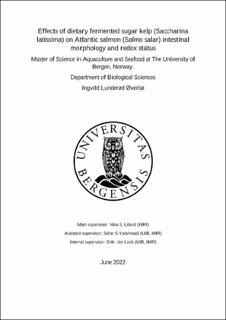| dc.description.abstract | The aquaculture industry is the world’s fastest growing food production sector and there is a demand for new feed ingredients from lower marine trophic levels to replace the marine and vegetable resources now used in aquafeeds. Seaweeds, such as sugar kelp (Saccharina latissima), have been suggested as one such candidate due to their low use of resources and potential for net zero environmental impact. The low protein and high crude fiber content have until now limited their use in feed for carnivore fish species like Atlantic salmon (Salmo salar). A practical solution to this may be fermentation. However, little is known about how fermented sugar kelp (FSK) affects the intestinal health and redox status of fish. The aim of this study was to evaluate if an inclusion of FSK in feed for Atlantic salmon post- smolt would affect any gut morphological parameters and redox status in the first segment of the mid intestine. A dose- response study with FSK inclusions of 1, 2, 3, and 4% was performed with Atlantic salmon post- smolt in triplicate groups over 10 weeks. A commercial relevant fish meal- based diet was formulated as reference. Growth and feed utilization were studied, and a morphometric analysis as well as a semi- quantitative evaluation of the gut morphology in the mid intestine were performed. In the same intestinal segment, a quantifiable analysis of the mucous cells was performed. Additionally, the redox status in the mid intestine was evaluated with the GSH/GSSG ratio as a biomarker. The results demonstrated that the Atlantic salmon fed FSK inclusions ≤2% performed similar to the control group on growth performance and feed utilization, but a dose dependent decrease in final body weight and specific growth rate (SGR) was seen in fish fed FSK inclusions ≥3%. No morphometric changes due to dietary modulations were detected in the mid- intestine, but an increased amount of submucosal connective tissue was seen in the fish fed FSK 2% through semi- quantitative evaluation. Dietary FSK neither affected the number nor the size of mucous cells. An enhanced total glutathione (GSH) was seen in the fish fed FSK 1%, but the GSH/GSSG ratio was not affected by diet. Based on the results from this study, the suitable inclusion of fermented sugar kelp in diet for Atlantic salmon is sat to 2%. However, to determine the real potential of fermented sugar kelp as a feed ingredient for Atlantic salmon, further research is needed. | |
